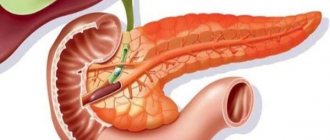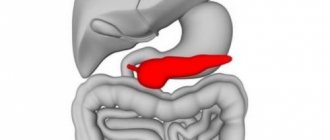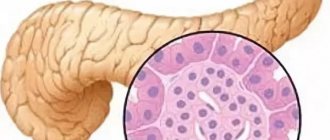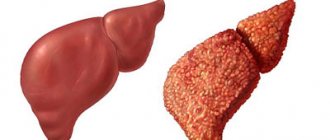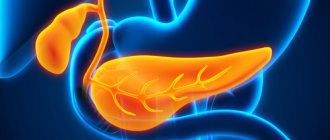Atrophy of the pancreas is characterized by a decrease in the organ’s volume, compression of its structure and a reduction in the functions it performs. This process can begin to form due to damage to the internal tissue and its compression, poor circulation, age-related changes and long-term diseases that debilitate the body. The weight of the pancreas of a healthy person ranges from 80 to 90 g, and the weight with atrophic changes can range from 40 g and below. A non-standard type of atrophy is lipomatosis, in which case the main part of the organ tissue is replaced by a fatty layer. Basically, atrophy concerns the head or tail of the pancreas, the rest of the pancreas is most often not deformed.
Causes
The pancreas is one of the most important human organs. It is she who secretes the enzyme for the body to digest food. When the functions of the gland are impaired, pancreatic juice begins to irritate the organ itself, corroding its cells. This disease is expressed in abnormal changes in glandular cells and an increase in the number of connective tissues.
The main reasons for the development of atrophy:
- Natural aging of the body.
- Presence of chronic pancreatitis.
- Frequent attacks of acute pancreatitis (if zones of necrosis have formed in the liver).
- Diabetes mellitus (its complication on the pancreas).
- Lipomatosis.
- Frequent consumption of alcoholic beverages (the last stage of alcoholic pancreatitis).
- Long experience of smoking cigarettes.
- The diet consists mainly of fatty foods.
- Frequent consumption of canned food and processed foods.
- Oncology (if the tumor puts pressure on an internal organ).
- Autoimmune diseases.
- Pancreatic resection.
- Systemic scleroderma (autoimmune disease of the subcutaneous tissue).
- Kidney stones (blocking of the urinary ducts with stones).
- Ulcer of the duodenum and stomach cavity.
Risk group:
- Heredity.
- Alcoholism.
- Gastrointestinal tract injuries;
- Infectious lesion of internal organs.
- Calculous cholecystitis (progressive stage).
If you experience nausea or vomiting, consult your doctor; these may be causes of pancreatic deformation
Symptoms of atrophy
The disease is characterized by swelling of the pancreas, poor circulation, the occurrence of necrosis and the formation of cysts. For these reasons, external exocrine insufficiency occurs. The body's absorption of vitamins and microelements is impaired, the skin gradually turns pale, taste buds are distorted, and the muscles become loose and flaccid. Atrophic processes can last up to 10–15 years from the diagnosis of chronic pathology. The main complaints of patients are reduced to disorders of the digestive system.
And also this type of disease is characterized by the following symptoms:
- Lack of appetite.
- Bloating after eating.
- Feeling of nausea, turning into vomiting.
- Pale and dry skin.
- Discharge of feces with a high fat content (steatorrhea), diarrhea.
- Red tint to the surface of the tongue, plaque, dental imprints.
- Intense pain under the ribs, mainly on the left side.
- Unexplained weight loss.
IMPORTANT! If you notice these symptoms in yourself, you should immediately consult your doctor.
Pale and dry skin may indicate a problem with the pancreas; if you notice these symptoms, consult a specialist
Diagnosis of the disease
Diagnosis of pancreatic atrophy begins with an external examination of the patient by the attending physician to determine the condition of the skin and weight standards. The doctor conducts a survey on the patient’s hereditary predisposition, as well as complaints that bother him. Palpation examination is also carried out, but often to no avail, since it is impossible to determine the reduction of the internal organ from the outside. After which the doctor prescribes a blood test, which can reveal a decrease in pancreatic enzymes, elevated blood sugar and anemia.
If there is insufficient basis for diagnosis, the following tests are prescribed:
- Coprogram is a study of stool for the amount of fat present in it; if more than 9% fat is present in the stool, this indicates the development of atrophic processes.
- Ultrasound examination (ultrasound) – examination of an internal organ for reduction in volume, formation of scars and contour irregularities.
- Biopsy - a study will show the extent of organ damage, which greatly facilitates the diagnosis.
- Magnetic resonance imaging (MRI) - a study is carried out for more accurate visualization of the organ.
A reddish tint of the tongue, plaque and teeth marks may indicate the development of atrophic processes in the body
Treatment of atrophic pancreatitis
Primary therapeutic measures are aimed at relieving pain and stopping inflammatory processes in the pancreas. Further treatment is carried out against the background of diet therapy and complex drug therapy. Atrophic pancreatitis is treated by a gastroenterologist in a specialized clinic. Only a doctor prescribes a therapeutic diet and a course of medications to the patient, taking into account his medical history, analysis of laboratory tests, individual characteristics of the body and the clinical picture of the disease.
Significant for the effective treatment of pancreatic atrophy is the correct and timely diagnosis of concomitant diseases. For these purposes, doctors of other specializations, primarily endocrinologists, can be involved.
Reduction of pain is achieved by prescribing antispasmodics and analgesics. To improve the functioning of the main pancreatic duct and relax the smooth muscles of the sphincters, medications such as Papaverinne, No-shpa, Odeston, Drotaverine are used.
After stopping the inflammation of the pancreas, the doctor performs detoxification procedures for the digestive and excretory system. As a result, hydroionic and acid-base balance is achieved. As prescribed by a doctor, infusions and decoctions of medicinal herbs can be used as additional means to remove toxins from the body.
To restore the secretory function of the pancreas, therapy is carried out with enzyme preparations: Festal, Mezim, Creon, Ermital, Pancreatin. These medications are taken exclusively as prescribed by the attending physician and under his supervision. The key to the effectiveness of treatment lies in the regularity of their use and compliance with the dosage prescribed by the gastroenterologist.
In severe and very severe stages of atrophic pancreatitis, conservative therapy may be powerless. In this case, urgent surgical intervention is necessary.
Atrophy of the pancreas is characterized by a decrease in the organ’s volume, compression of its structure and a reduction in the functions it performs. This process can begin to form due to damage to the internal tissue and its compression, poor circulation, age-related changes and long-term diseases that debilitate the body. The weight of the pancreas of a healthy person ranges from 80 to 90 g, and the weight with atrophic changes can range from 40 g and below. A non-standard type of atrophy is lipomatosis, in which case the main part of the organ tissue is replaced by a fatty layer. Basically, atrophy concerns the head or tail of the pancreas, the rest of the pancreas is most often not deformed.
Treatment
When treating this disease, it is very important to follow a diet. The following should be excluded from your daily diet:
- Alcoholic drinks.
- Foods with a high fat content.
- Flour confectionery products.
- Sweets.
It is necessary to stop smoking tobacco products, as they have a toxic effect on the pancreas. Treatment is based on pain relief, removal of toxic substances from the pancreas, as well as restoration and normalization of metabolism.
For cooking, use mainly chicken, rabbit and turkey meat. When treating the pancreas, it is recommended to cook them in a stew. Meat dishes are allowed to be baked. Protein products should predominate in the diet. Carbohydrate foods should be reduced to the required minimum and exclusively in the form of complex carbohydrates. Avoid overeating and eating large portions; eat small and even meals 5-6 times a day. Frequent consumption of small portions stimulates the functioning of the pancreas.
Proper and balanced nutrition is the key to health and prevention of any disease.
The following medications are allowed:
Pancreatic fibrolipomatosis - what is it?
- No-spa (for pain relief).
- Papaverine (for pain relief).
- Pancreatin (to improve digestion).
- Mezim (to improve digestion).
In the absence of vitamins and microelements, they are supplied to the body by injection.
In severe stages of the disease and when medications are ineffective, surgical intervention is prescribed. This is explained by the death of cells and tissues of the pancreas, after which the only option for recovery is a donor transplant.
Treatment of pancreatic atrophy
Conservative activities
In case of pancreas atrophy, diet therapy is necessarily prescribed. The diet should be low in fat. Enough attention should be paid to protein-energy deficiency and correction of hypovitaminosis. A mandatory measure is to completely stop smoking, since nicotine disrupts the production of bicarbonates by the pancreas, as a result of which the acidity of the contents of the duodenum significantly increases.
The main direction of treatment for this pathology is the replacement of exocrine and endocrine secretions of the pancreas. To compensate for impaired cavity digestion processes, a gastroenterologist prescribes enzyme preparations. To achieve a clinical effect, drugs must have high lipase activity, be resistant to the action of gastric juice, ensure rapid release of enzymes in the small intestine, and actively promote cavity digestion. Enzymes in the form of microgranules meet these requirements.
Since it is lipase that loses activity most quickly of all pancreas enzymes, correction is made taking into account its concentration in the drug and the severity of steatorrhea. The effectiveness of treatment is assessed by the content of elastase in feces and the degree of reduction of steatorrhea. The action of enzyme preparations is also aimed at eliminating pain, reducing secondary enteritis, creating conditions for normalizing intestinal microbiocenosis, and improving carbohydrate metabolism.
Correction of endocrine insufficiency is carried out through insulin therapy. With pancreatic atrophy, the islets of Langerhans are partially preserved, so insulin is produced in the body, but in small quantities. The dosage and regimen of insulin administration are determined individually depending on the course of the pathology, etiological factor, and data from daily blood glucose monitoring. The administration of enzyme preparations significantly improves the function of the pancreas in general and carbohydrate metabolism as well. Therefore, the insulin therapy regimen is determined depending on the dosage and effectiveness of enzyme replacement therapy.
An important condition for the effective correction of digestive functions is the normalization of intestinal microbiocenosis, since the intake of enzymes creates favorable conditions for the colonization of pathogenic flora. Probiotics and prebiotics are used. Injection vitamin therapy, as well as magnesium, zinc, and copper preparations, are required.
Surgery
Surgical treatment of this pathology is carried out in specialized centers. Transplantation of the islets of Langerhans is performed, followed by removal of the gland and enzyme replacement therapy. However, since atrophy is often a consequence of severe illnesses with a pronounced impairment of the patient’s general condition, such treatment is rarely carried out.
Prevention
Pancreatic atrophy is a life-threatening complication. Rather than treating an established disease, it will be better to prevent its occurrence. To do this, it is necessary to take timely measures to treat the diseases that precede it. An active lifestyle is the best cure for all diseases, pancreatic atrophy is no exception. Proper nutrition also plays an important role. Even a healthy person needs adequate and well-composed intake of proteins, fats and carbohydrates per day. For sweets, give preference to berries, fruits and vegetables, as they contain a high content of minerals, trace elements and amino acids, which are so required by the human body.
Playing any kind of sport is the best prevention of almost all diseases.
Let's summarize. Pancreatic atrophy is a decrease in the mass of the organ. This negatively affects the digestive system and causes pain and discomfort to the person. To avoid the formation of atrophic processes, you should adhere to a healthy lifestyle (do not smoke, do not drink alcoholic beverages often and in large quantities). The daily diet should be uniform, without overeating. If you are diagnosed with diabetes mellitus, you should limit yourself in eating sweets, as this may be the cause of the formation of this complication.
Pancreatic atrophy
Pancreatic atrophy
is a decrease in organ volume, manifested by insufficiency of exocrine (production of digestive enzymes, bicarbonate) and intrasecretory (synthesis of insulin, glucagon) functions. The most common causes of pathology are chronic pancreatitis, diabetes mellitus, somatic diseases with severe exhaustion, as well as cirrhosis of the liver, impaired blood supply, and compression by a tumor. Diagnosis is based on laboratory data revealing enzyme deficiency and low insulin levels, ultrasound of the pancreas, and biopsy results. Treatment consists of prescribing replacement therapy: enzyme preparations, insulin; restoration of intestinal flora; correction of nutrient deficiencies.
